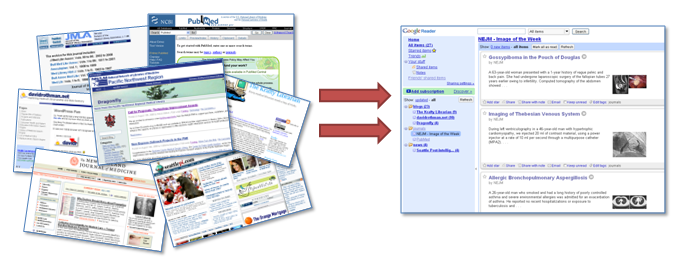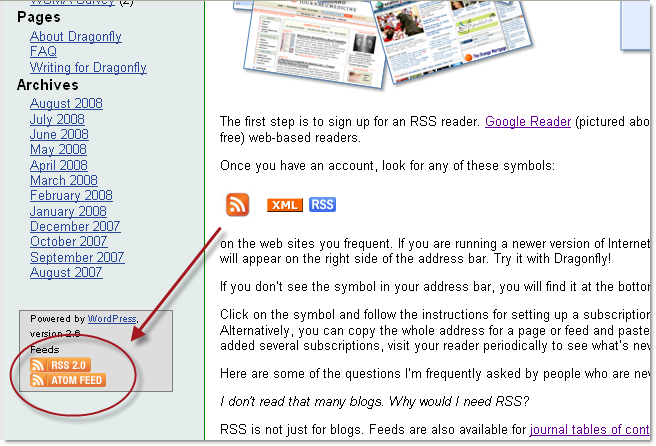Sep
02

Posted by Alison Aldrich on September 2nd, 2008
Posted in: Technology
RSS (Rich Site Syndication, or Really Simple Syndication) is changing the way people receive and manage information. This technology has been around for several years and is increasingly being adopted by mainstream internet users. More than likely, this includes people you serve at your library or information center. If you have yet to jump on the RSS bandwagon yourself, read on.
RSS saves you the hassle of having to visit your favorite blogs and websites one by one to check for updates. With RSS, the updates come to you. You can access news feeds from all of your favorite sources through a single access point.

The first step is to sign up for an RSS reader. Google Reader (pictured above) and Bloglines are two popular (and free) web-based readers.
Once you have an account, look for any of these symbols:
![]()
on the web sites you frequent. If you are running a newer version of Internet Explorer or Mozilla Firefox, the symbol will appear on the right side of the address bar. Try it with Dragonfly!
![]()
If you don’t see the symbol in your address bar, you will find it at the bottom left of Dragonfly’s navigation bar:

Click on the symbol. In newer versions of web browsers, you will see a menu of subscription options. Select the RSS reader you chose in the first step, enter your username and password if asked, and you’re subscribed!
If you don’t see subscription options (or if you see code that is difficult to read) copy that page’s entire address from the address bar. Go to your RSS reader and find an “Add Subscription” option. Paste the address directly into your reader.
Once you’ve added several subscriptions, visit your reader periodically to see what’s new.
Here are some of the questions I’m frequently asked by people who are new to RSS:
I don’t read that many blogs. Why would I need RSS?
RSS is not just for blogs. Feeds are also available for journal tables of contents, PubMed searches, podcasts, photo sharing sites, social bookmarking sites, and more. You can even subscribe to MEDLIB-L as a news feed.
Isn’t this just another password to remember / something else I’ll have to find time to do?
Think of it as a way to streamline what you’re already doing to continually educate yourself about developments in your field. Don’t feel like you’re doing enough? With an RSS reader, you can quickly scan any number of information sources at a single glance. Read, save, and share items that are of interest to you, and ignore the rest! No guilt!
Couldn’t I accomplish the same thing with e-mail alerts?
It’s true; many sites that offer RSS news feeds also offer e-mail alerts. Personally, I find it useful to separate news items and professional reading, which I can tackle as time permits, from e-mail messages requiring my personal attention. Using an RSS reader for news reduces clutter in my inbox and makes it less likely that I will overlook a time-sensitive message.
I encourage you to give RSS a try. Let me know how it’s working for you! Comments on this post are welcome.
—
Coming next week: Thoughts on talking to health professionals, students, faculty, staff, and the public about the benefits of RSS.